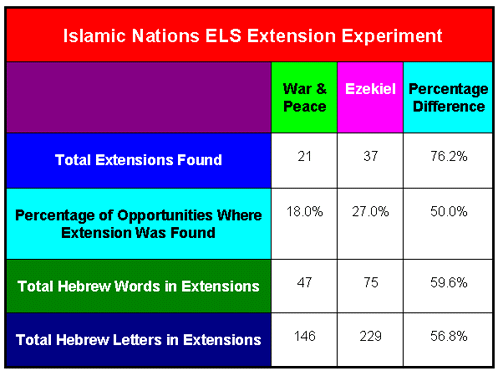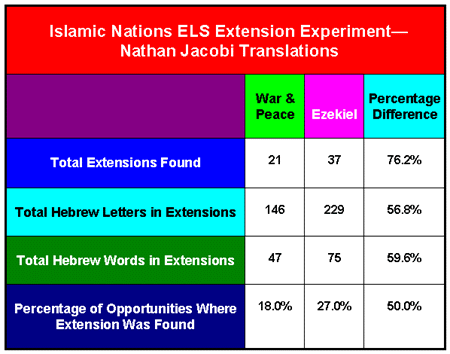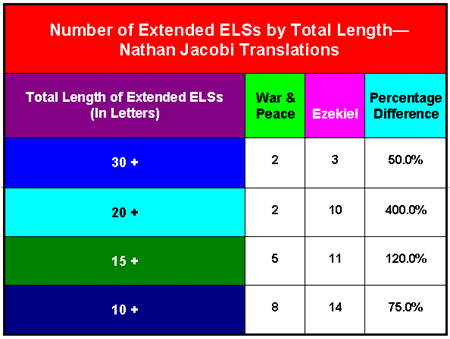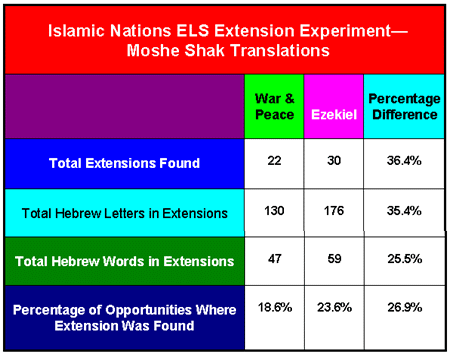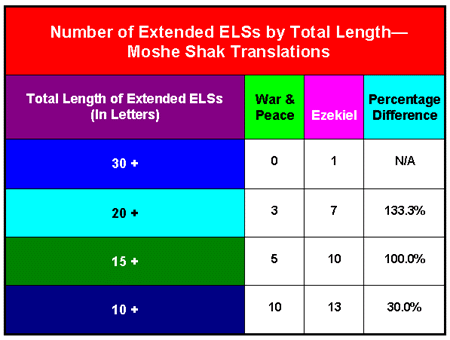Please let me know if you want on or off the list
This segment from:
HERE: http://www.biblecodedigest.com/page.php/153
---------------------------------------------------------
We then conducted a blind experiment with the participation of our Hebrew expert, Dr. Nathan Jacobi. We sent him five occurrences from Ezekiel (and five occurrences from War & Peace) of the name of each of the above nations as an ELS. We asked him to tell us whether letters before and after the terms created longer terms. Throughout the experiment, and to this day, Dr. Jacobi has not known which of the initial ELSs and surrounding letter strings were from Ezekiel and which were from War and Peace.
This experiment was conducted over a six month period by slipping in both of these sets of letter strings without Nathan knowing when we started doing so and when we were finished. We also were continuing to submit to him our regular supply of letter strings from other parts of the Bible on other topics as part of a number of research projects. (Curiously, at one point in this process, soon after we had submitted a sizeable group of Islamic nation ELSs, he commented that he was getting rather frustrated about how few long codes he had been finding lately and that he was thinking of quitting such searches altogether. He noted that he felt that he was “losing his touch.”)
Perhaps the most surprising result of the experiment was that two of the longest ELSs Nathan found were from War and Peace. These ELSs were each more than 30 letters-long, and represent the longest ELSs of which we are aware from any text other than the Bible. These long ELSs clearly underscore the fact that lengthy ELSs can be found in any Hebrew text, however uninspired.
On the other hand, eight of the ten longest ELSs were from Ezekiel. Apart from the two long ELSs in War and Peace, there was a relative dearth of long ELSs that emerged from Tolstoy’s novel.
In a future issue we will be disclosing the Hebrew and English of all the extended ELSs (as well as their specific lengths). At this point another phase of the experiment is being designed. It is likely that in this phase it will be essential that our participant(s) be blind as to the source text of each extended ELS.
In this experiment we counted the total number of extensions found around 50 initial ELSs in Ezekiel and 50 initial ELSs in War & Peace. An extension is a phrase or brief sentence that appears entirely on one side of an existing ELS. The extension must represent a grammatically reasonable continuation of the existing ELS. As such, it could either incorporate part of the existing ELS or be a stand alone phrase or sentence that could reasonably precede or follow the existing ELS. It is of course possible to find several extensions around an initial ELS to form one lengthy final ELS. The average extension found in this experiment consisted of two Hebrew words that totaled seven letters.
The following table summarizes the results of the experiment. In all, 21 ELS extensions were found around the initial ELSs in War & Peace, while 37 extensions were located by Nathan in Ezekiel. This represents a 76.2% higher frequency of extensions in Ezekiel, a difference that is clearly statistically significant:
As the above table shows, there were 47 Hebrew words in the entire group of extensions from the control text, whereas there were 75 from Ezekiel, a 59.6% difference. And there were 146 letters in the control extensions, versus 229 in the Ezekiel extensions, a 56.8% difference.
A useful statistic that emerged from this experiment was an estimate of the percentage of opportunities for finding an extension in the control text. That rate of “discovery” was 18.0%. Having that rate, one can determine how many long ELSs of various lengths would be expected from a control text. We did exactly that for the Ezekiel 37 cluster in a later article in this issue. We then compared the actual number of long ELSs found in Ezekiel 37 with those expected by chance for several length categories. By doing so, the probability that a cluster as extensive as Ezekiel 37 could be the result of chance can be reasonably estimated using standard testing procedures.
The rate of discovery in Ezekiel was 27.0%, which is 50.0% higher than the discovery rate of 18.0% from Tolstoy’s novel. The discovery rate is defined as the ratio of the actual number of extensions found to the number of opportunities available for potentially finding an extension. At the beginning of each search of a new letter string, there are two opportunities to find an extension—one before the name of the given Islamic nation, and one after. If an extension is found, one new opportunity (not two new opportunities) to find yet another extension is created. That opportunity will consist of the new letters that are now next to the extension that had just been discovered. There is no new opportunity on the other side of the ELS where an extension wasn’t found, since that opportunity has already been counted.
Why is it that the total number of extensions found in Ezekiel was 76.2% higher than in War & Peace, while the discovery rate was only 50.0% higher? It is because the denominators are not the same. Each new extension opens up a new opportunity to find yet another extension. So there were many more opportunities to find new extensions in Ezekiel because more extensions were initially found in Ezekiel.
We also noted that:
- The average number of Hebrew letters per word in the extensions found was 3.05 in Ezekiel and 3.11 in War & Peace.
- The average number of Hebrew words in the extensions found was 2.03 in Ezekiel and 2.24 in War & Peace.
- The average number of Hebrew letters in the extensions found was 6.19 in Ezekiel and 6.95 in War & Peace.
- The discovery rate is 18.0% of the opportunities for finding extensions.
- The average number of Hebrew letters to be found in extensions is assumed to be 7.0 (the actual average was 6.95 in War & Peace).
Derivation of this formula is detailed in the Technical Addendum HERE http://www.biblecodedigest.com/page.php/150
We applied this model to the Ezekiel findings and determined how many final ELSs would fall in different length categories if the search had been done in a non-encoded text. A p-value calculated by EXCEL’s CHITEST function indicated that the odds that the Ezekiel results from the Islamic Nations Experiment could be due to chance were 1 in 81,303. Given this level of improbability, the Ezekiel findings should be viewed as being statistically significant. This provides definitive evidence that some ELSs from the Ezekiel group are intentional.
TO BE CONTINUED IN THE NEXT SEGMENT
